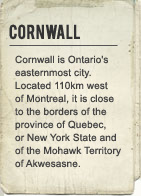Cornwall is Ontario's easternmost city. Located on the St. Lawrence River 110 kilometres southwest of Montreal, it is close to the borders of the province of Quebec, New York State and the Mohawk Territory of Akwesasne. Cornwall is a bilingual, bicultural city. In 2006, its population was 45,965; of this number, 65 percent had English as their mother tongue and 27 percent had French.
First Nations peoples have lived in and around the Cornwall area for millennia. European settlement took place after the American War of Independence. When the United Empire Loyalists came across the border with their families. The city was named for Prince George, the Duke of Cornwall. Cornwall's strategic location made it an ideal garrison town, communications and supply post during the War of 1812.
Cornwall was incorporated as a town in 1834. Construction of the Cornwall Canal in 1834-1842 provided transportation and water power for the flour mills, wool mills, tanneries and later, textile factories, that were springing up along the waterfront. In the 1870s and 1880s, textile and paper mills revitalized the community. Large numbers of French-speaking, Catholic Québecois came to Cornwall to work in the vital cotton processing industry, as did experienced textile workers from New England.
Another period of explosive growth occurred in the 1920s. A large part of this boom can be attributed to the British-owned Courtaulds Canada Inc. rayon manufacturing plant, established in 1924. It operated until 1992. The Toronto Paper Company (est. 1883), which eventually operated as a division of Domtar Fine Papers, was also a major employer until its closure in 2006. On 10 August 1954, the St. Lawrence Seaway and Power Project was launched. It was the largest international hydroelectric dam ever built. With the closing of the cotton mills in 1959, a steady economic downturn began.
Today, Cornwall is taking steps to recraft its image as "a city with a world of possibilities." It offers recreational water sports, marina, golf, camping and theatres. Various special events take place during the year including the popular "Lift Off" hot air balloon festival each summer. Its economy today is more diversified, with a mix of light manufacturing, automotive, high tech, food processing, and call centres. It also has two post-secondary institutions, hosting a campus of the St. Lawrence College of Applied Arts and Technology and a satellite campus of the University of Ottawa.










